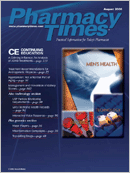Publication
Article
Pharmacy Times
Shire Pharmaceuticals' Daytrana
Author(s):
In April 2006, the FDA approved Shire'sDaytrana (methylphenidate), the first andonly transdermal treatment for attentiondeficit/hyperactivity disorder (ADHD).Daytrana should be used in conjunctionwith nonpharmacologic treatment.1,2
Pharmacology
Methylphenidate is classified as acentral nervous system (CNS) stimulantand affects the CNS with minimal cardiovasculareffects. The exact mechanismof methylphenidate is unknown,although it is thought to activate subcorticalstructures including the thalamus,the brainstem arousal system, andthe cortex. This activation in turn producesa stimulatory effect. It has yet tobe determined how methylphenidateexerts behavioral effects on children.1
Pharmacokinetics
Methylphenidate is a racemic mixtureof d-and l-enantiomers, where d-enantiomeris considered the more pharmacologicallyactive metabolite. The transdermalformulation bypasses first-passmetabolism, leading to increased exposureto d-methylphenidate (d-MPH).Compared with oral methylphenidate, alower mg/kg dose of Daytrana is neededfor higher d-MPH exposure.1
A phase 3 trial demonstrated themean plasma peak concentrations of d-MPH as 39 ng/mL (range 0-114 ng/mL).The trial also determined an inverselyproportional mean peak concentrationof 25 ng/mL for 12 year olds (range 2-80 ng/mL). For 6-year-olds, the meanpeak concentration was 53 ng/mL(range 18-83 ng/mL).1 Lag time forDaytrana is an average of 3.1 hours(range 1-6 hours).
Clinical Trials
The efficacy of Daytrana was shown ina randomized, double-blind, doubledummy,multicenter, parallel-group, placebo-controlled study in children who wererandomized in a 1:1:1 ratio to receive amethylphenidate patch, a matching placebopatch, an osmotically released oral system(OROS) methylphenidate tablet, or amatching placebo tablet.3
The study enrolled children aged 6 to12 years who had been diagnosed withADHD. Patients who showed at least a25% reduction in scores on the ADHDrating scale (ADHD-RS) were maintainedon their optimal dose for 2weeks. Patients treated with themethylphenidate patch displayed statisticallysignificant improvement on all3 scales, compared with placebo.3
Safety
Common adverse events includeinsomnia, nervousness, loss of appetite,abdominal pain, weight loss, headache,tachycardia, aggressive behavior, andvisual disturbances. Daytrana also mayirritate the skin.1 Overdose symptomsinclude vomiting, agitation, tremors,hyperflexia, convulsions, euphoria, confusion,hallucinations, delirium, sweating,cardiac arrhythmias, and mydriasis.
Daytrana is contraindicated in patientswith glaucoma, tics or a family history ofTourette's syndrome, hypersensitivity tomethylphenidate, anxiety, tension, agitation,preexisting psychosis, seizures, orconcomitant use of monoamine oxidaseinhibitors. Daytrana is characterized as apregnancy category C drug.
Dot Matrix Technology
Dot matrix technology includes a layerof acrylic that holds a large volume ofdrug. Silicone adhesive is used to keep thepatch in place during everyday and rigorousactivity, such as exercising and swimming.3,4 This technology creates an evenlydispersed drug patch and in turn providesreproducible blood levels of medications.
Daytrana is designed to releasemethylphenidate continuously. Once thepatch is removed, residual methylphenidateremains under the skin andcontinues to be distributed. Therefore,methylphenidate plasma concentrationsdecline in a biexponential manner.1
Patch Instructions
The patch is applied on an alternatinghip each day to a clean, dry area 2 hoursbefore the effect is desired. It should beworn for a total of 9 hours (it may beremoved earlier if a shorter duration ofeffect is desired).1 The patch should not beapplied to open, cut, red, or irritated skin.
Methylphenidate release is increasedif external heat is applied. Therefore,patients should be warned not to useheating pads or electric blankets whilewearing a Daytrana patch. Daytrana is aSchedule II drug and may lead to dependence.Detailed patient information onpatch application is included in the packageinsert.
Caryn Domenici, RPh, and Alka Patel, PharmDMs. Domenici and Ms. Patel are bothpharmacists at Brigham andWomen's Hospital, Boston, Mass.
For a list of references, send a stamped,self-addressed envelope to: ReferencesDepartment, Attn. A. Rybovic, PharmacyTimes, Ascend Media Healthcare, 103 CollegeRoad East, Princeton, NJ 08540; or send anemail request to: arybovic@ascendmedia.com.







